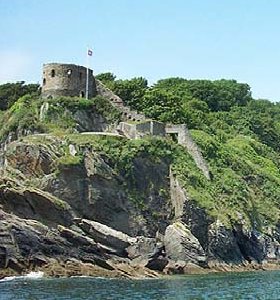


Fowey, PL23 1JH
Tel: (0117) 9750700
Email: southwest@english-heritage.org.uk
Web: www.english-heritage.org.uk/visit/places/st-catherines-castle
One of a pair of artillery forts built by Henry VIII
St. Catherine's Castle is situated on the tip of the rocky headland known as St. Catherine's Point at the entrance to the River Fowey Estuary. This prominent site has potentially been of varying importance since prehistory; for example, the Ordnance Survey map of 1880 shows extensive earthworks suggestive of a late prehistoric cliff castle here. A medieval chapel to the north of St. Catherine's Castle was replaced in the 19th century by a granite arched mausoleum commemorating the Rashleigh family which stood within contemporary ornamental gardens on the slopes above Readymoney Cove.
A D-shaped two storey blockhouse was commissioned on the site in 1540 by Henry VIII to strengthen the harbour defences as part of a response to increased military threat from Spain and France in the aftermath of the Reformation. It was built by Thomas Treffry to replace two earlier blockhouses built in 1380 on opposite sides of the estuary at Fowey and Polruan, still visible today. It was built on a prepared platform in the rock on the highest point of ground giving it uninterrupted and all encompassing views along the estuary and out to sea. Splayed gun ports on the ground and first floors would have allowed for observation and small arms fire. A parapet walk flanked by high battlements containing further gun embrasures would have given further protection. Steep slopes fall away from the blockhouse walls to a curtain wall and rectangular bastion which meets the precipitous cliffs either side. This was added prior to 1734 and subsequently modified during major refurbishment of the site in 1855 during the Crimean War. At this time a battery for two guns was added, built onto a level platform below and slightly east of the blockhouse, with a magazine for storing ammunition built into the rock beside the entrance to the curtain wall. A series of square granite plaques commemorates the refurbishments and documentary evidence of 1887 records the Crimean War battery as being armed by two 64-pounder rifled muzzle-loading guns manned by Artillery Volunteers. The practice battery was abandoned by the end of the 19th century as the guns became obsolete.
The last time it came under fire was when the Dutch fleet threatened Fowey harbour 1667 and responded with furious canon fire from here and Polruan Blockhouse.
During World War Two St. Catherine's Point became a gun battery and observation post. The south-westerly of the two Crimean gun emplacements was modified to take a 4.7 inch naval gun and a large protective concrete shelter and neighbouring pill box were constructed. A further gun was mounted on the higher ground to the west of the site, whilst the blockhouse became the firing point for a controlled minefield laid across the mouth of the Fowey Estuary. The site was dismantled after the war.
St. Catherine's Castle is now managed by English Heritage.
The Castle can be accessed by the coastal path leading south-west out of Fowey through Covington Woods.
Opening TimesAll Year Admission Free |
Cornwall's History Fowey Polruan Polruan Blockhouse The River Fowey
Pendennis Castle Restormel Castle St. Mawes Castle Tintagel Castle Trematon Castle English Heritage in Cornwall